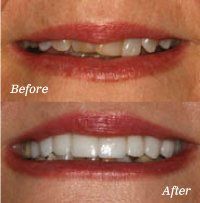Crowns Are the Natural-Looking Repair for Damaged Teeth
A versatile restorative dentistry solution, porcelain crowns are the go-to repair for many oral health problems. Damaged teeth can be covered up with a customized porcelain crown, which is fitted and bonded in place by one of the experienced dentists at Kings Park Dental Center in Burke, VA.
What Problems Do Porcelain Crowns Fix?
Damaged teeth are uncomfortable and make it difficult to chew, and they don’t look very nice either. If there is one sure thing that can make you self-conscious, it’s a broken or unsightly tooth. Porcelain crowns are used to repair, correct, restore, protect, or cover teeth with problems such as:
- Chips
- Cracks
- Weakness
- Gaps and spaces
- Fractures
- Misshapenness
- Damage
- Discoloration and stains
- Large cavities
Essentially, porcelain crowns are little caps that cover unattractive teeth so that your smile is complete.
Are All Tooth Crowns the Same?
There are several types of materials used to make tooth crowns. What your crown is made of will depend on the materials your dentist favors, the condition of your tooth, any metal allergies you have, your aesthetic wishes, and the material that is best for your oral health. Common types of tooth crowns include:
- All-porcelain crowns: Made of porcelain or engineered dental ceramic, all-porcelain crowns are one of the most popular restoration options. The composition of the crown is kind to patients with metal allergies. And, for every patient, the crown is a strong and durable replacement for a compromised tooth. Plus, the final product is a natural-looking restoration that blends in with the rest of your teeth.
- Porcelain-fused-to-metal crowns (PFM): With a porcelain exterior and metal interior, PFM crowns are very strong and are still able to be matched to your existing tooth color. However, the metal composition of the crown can be problematic for some patients.
- Metal crowns: Typically made of just one metal, like gold, metal crowns are noticeable, and the patients who choose them usually request such a look. Metal crowns are very durable, but they’re definitely not for everyone.
- Ceramic zirconia crowns: Ceramic zirconia is metal-free, which is great for allergy sufferers. This version of a crown is also very strong and fracture resistant and, like all-porcelain crowns and PFM crowns, is designed to match the color of your natural teeth.
How Are Porcelain Crowns Applied?
Porcelain tooth crowns are meant to improve the appearance, functionality, and strength of a tooth. This procedure usually takes two visits to your Burke dentist at Lifetime Smiles to complete.
During the first appointment, your tooth will be prepared, sanded, and shaped so the custom-designed crown will be able to fit snugly in place. Your dentist will take an impression of the tooth and order a customized crown to be created by the dental lab. A temporary crown will be put in place while you wait for your restoration to be complete so you don’t have to be worried about your appearance.
The temporary crown will be removed during the second dental appointment, and the permanent tooth crown will be bonded to your damaged tooth. The result: a complete and stunning smile that looks natural and works perfectly.
The Many Uses of Porcelain Crowns
Porcelain crowns are used most often used to repair the structure of a damaged tooth. But crowns also serve as a great solution for replacing old dental work. Amalgam fillings can expand and cause teeth to crack over time. If a tooth has a large cavity or needs a significant filling, a crown can be used instead.
Make An Appointment
Old restorative dentistry solutions – even the most secure – can need a replacement after decades of use. New porcelain crowns make an attractive repair. Patients who undergo root canal therapy typically need a porcelain crown to cover their problem tooth and seal the repair in place.
And finally, crowns are usually used in conjunction with a fixed dental bridge. The crowns serve as anchors on either side of the bridge to hold it in place and take the place of a missing tooth or teeth.
Allow your porcelain crown repair to do the work of your natural teeth in both form, function, and appearance. Contact Drs. Bursich or Fassnacht at Kings Park Dental Center in Burke, VA, to discuss porcelain crowns and other restorative dentistry solutions.
